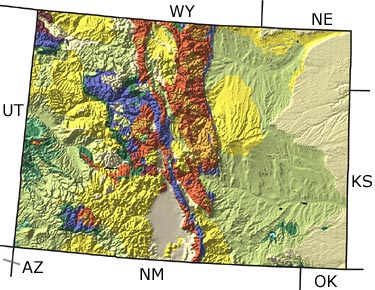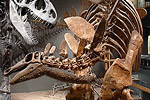Colorado, US
|
|
|||||||||||||||||||||||||||||||||||||||||||||||||||||||||||||
Paleontology and geology
The Precambrian: Most of the Precambrian in Colorado consists of igneous and metamorphic rocks as old as 2.7 billion years. The only Precambrian sedimentary rocks in Colorado are located in the extreme northwest corner of the state. No Precambrian fossils have been reported.
The Paleozoic: The Paleozoic was a time of fluctuating sea levels. Colorado lay near the equator during much of the Early and Middle Paleozoic (Cambrian through Devonian) and a variety of marine fossils indicates that a shallow, tropical sea covered the state during this time. At some point in the Middle Paleozoic (Silurian or early Devonian), the sea retreated for a time and the state was subjected to a period of erosion before marine waters returned in the Carboniferous. Mountain-building events in the Late Carboniferous raised a series of ranges in western Colorado, and both terrestrial and shallow marine environments existed in low-lying areas between these ranges. Fossils of sharks, trilobites, brachiopods, and crinoids can be found in the marine sediments, while fossils of some of the earliest conifers, tree lycopods, and huge horsetail Calamites occur in terrestrial deposits. The seas retreated in the Permian, once again exposing much of the state to erosion, and resulting in extensive dunes, where fossilized tracks of insects and unknown reptiles can now be found.
The Mesozoic: Much of Colorado lay above sea level during the Triassic and Jurassic. Extensive floodplains and coastal lowlands developed at the edge of a shallow seaway. Dinosaurs, other reptiles, amphibians, and conifers flourished in these environments. During the Cretaceous, the shallow seaway expanded across the state. Dinosaur footprints and fossil flowering plants are common in the forested and swampy coastal areas that formed along its margins. As the seas deepened, thick deposits of muddy and limy sediments accumulated on the sea floor. These sediments are rich in fossils, including single-celled algae, molluscs, fish, and the bones of large marine reptiles. Just before the end of the Cretaceous, the seas retreated, the Rocky Mountains began to rise, and dinosaurs roamed a landscape covered by broadleaf trees and palms.
The Cenozoic: During the Early Cenozoic (Tertiary), the Rocky Mountains continued to rise and tropical rainforests grew along its slopes. Mammals, crocodiles, and turtles roamed the area. Huge lakes formed in low-lying areas between the rising mountains. Oil shales formed in these lakes are the source of beautifully preserved fossils of fish, leaves, and insects. Volcanic eruptions spread debris and ash into the Denver Basin. Later in the Tertiary, Sequoia forests flourished in the cooling climate, and grasslands spread across much of the state. Mountain glaciers carved the spectacular peaks and valleys of the Rockies during the Late Cenozoic (Quaternary). True prairies appeared, and mammoths, camels, bison, horses, and flourished.
Links to more on Colorado paleontology
Organizations | Education and Exhibits | Research and Collections | Resources
OrganizationsEducation and ExhibitsSocieties and Clubs (showing 1 of 1 listings)
Western Interior Paleontological Society: This site contains information about membership, meetings, field trips, and educational opportunities sponsored by the society.
Parks (showing 1 of 1 listings)
Florissant Fossil Beds National Monument: This official site of the National Park Service has information on the rocks and fossils at the monument, as well as information on how and when to get there, fossil images, and educational resources.
Museums (showing 3 of 3 listings)
Denver Museum of Nature & Science: The Denver Museum of Nature & Science has permanent and temporary exhibits about paleontology (Prehistoric Journey, Ancient Denvers)and mineralogy (Coors Mineral Hall).
Museum of Western Colorado's Dinosaur Journey: Provides information on visiting the museum, as well as the paleontology of western Colorado and surrounding areas.
Rocky Mountain Dinosaur Resource Center: A new 20,000 square foot dinosaur museum in Woodland Park, Colorado. Exhibits include huge marine reptiles, pterosaurs, dinosaurs, a visible fossil lab, educational activities, and an interactive children's area.
Government Agencies (showing 2 of 2 listings)
Colorado Department of Transportation: The mission of the CDOT Paleontology Program is to collect, preserve and facilitate the scientific study of important fossils and associated geologic and paleontological data that might otherwise be damaged or destroyed by CDOT construction and maintenance activities.
Colorado Geological Survey: The Colorado Geological Survey provides information about the various aspects of the geology and natural resources of Colorado, from minerals to fossils to avalanche hazards. You'll also find information on maps and other publications.
Research and CollectionsPhysical Exhibits (showing 1 of 1 listings)
Prehistoric Journey at the Denver Museum of Nature & Science: The Denver Museum of Nature & Science hosts Prehistoric Journey, a 13,000 square foot exhibit about the history of life on Earth.
Virtual Exhibits (showing 3 of 3 listings)
Ancient Denvers: Ancient Denvers is a virtual exhibit that highlights 13 reconstructions of ancient Colorado landscapes.
Ice Age Online: Ice Age Online, originally developed to accompany a temporary exhibit at the Denver Museum of Nature & Science, offers a wealth of information on the Pleistocene ice age, including profiles of ice-age vertebrates, and a discussion of how we know that the ice age occurred.
Fossil eggshell: Fragments from the past: This site explores the latest research on fossil eggshell and what an eggshell can tell us about the egg-layer — its anatomy, behavior, growth rate, identity, and more.
ResourcesResearchers (showing 1 of 1 listings)
Florissant Paleontology Collections Database: This database website includes information and photographs for more than 5000 of the published specimens of late Eocene plants and insects from the world-renowned site at Florissant, Colorado. The website allows the user to search the museum collections, the taxonomic placement of the fossils, and the bibliography of references. It is maintained by the National Park Service.
Ongoing Research Projects (showing 1 of 1 listings)
University of Colorado Natural History Museum: Among the largest collections of fossil vertebrates in the central United States, the University of Colorado Natural History Museum located in Boulder features exhibits, research collections and educational programs for the general public.
Field Guides (showing 2 of 2 listings)
Oceans of Kansas: Photographs, artwork, historical papers, and other information on the sea creatures, especially mosasaurs and plesiosaurs, that lived in the Western United States during the Cretaceous period.
Green River Paleobotany Project: This site is geared towards amateurs and professionals who collect fossil plants from the Parachute Creek Member of the Green River Formation in Colorado and Utah. The site provides an identification guide for more than 250 species of fossil plants and encourages collectors to submit images of their own fossils if they think they have found a new species.

